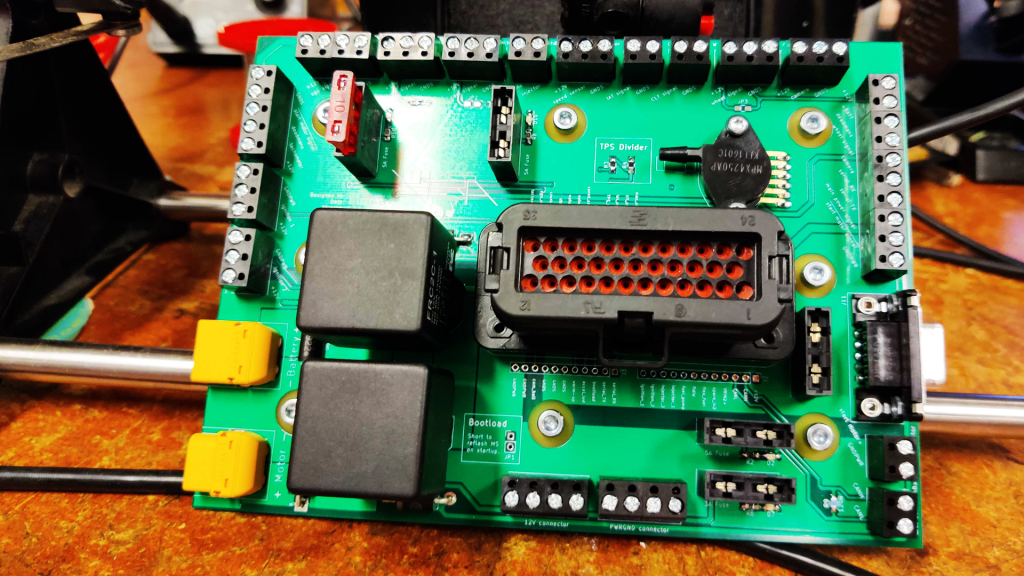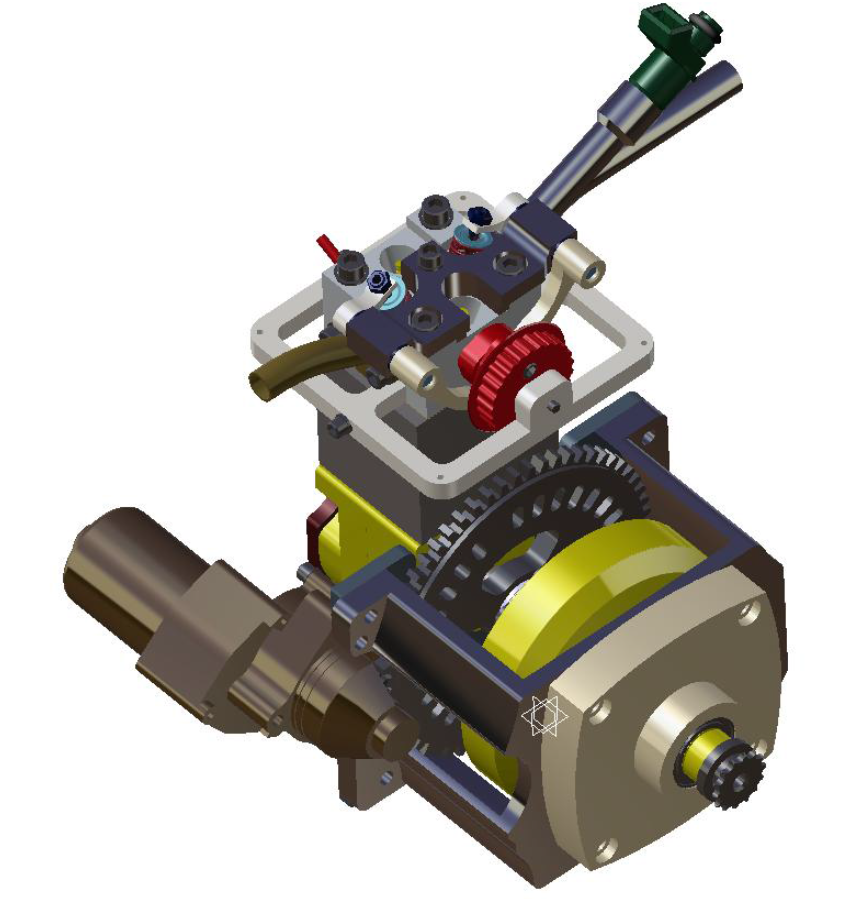History
The vehicle named Vera was developed in 2006. Year 2007 was the year of manufacturing and she finally saw daylight in the first half of 2007. Vera has undergone many changes during the years and can now be considered a venerable lady. In her first years she was propelled by the, in the context of eco marathon, very common GX35-engine produced by Honda. The engine was replaced in 2009 with an engine developed in house.
The vehicle was built up around a frame of carbon fiber, supporting all load taking elements. The body was bolted onto this frame. As years passed, the carbon fiber frame became weaker and in 2012 it was replaced by a frame of thin steel alloy tubes.
The vehicle consisted of three parts; two body panels and one load taking frame. The weight of the frame is roughly 8 kg whereas the body weighs close to 1 Kg. The frame was manufactured in thin walled CrMo steel tubes. The body was manufactured in single layer of carbon fiber. The vehicle had two steerable front wheels and one propelling rear wheel. The total weight of the car was roughly 30 kg.
Body and chassis
The current vehicle, VERA III, is made of one honeycomb-reinforced carbon fiber frame that is self-supporting, so no steel frame is needed. The frame/chassis weighs roughly 6 Kg and the car in total weighs about 28 Kg which was the second lightest vehicle at SEM 2015. Since 2015 the weight has varied a bit between the competitions with a official number of 33 kg for the 2019 vehicle.
Engine
The engine has been developed since 2010 and is currently in its seventh generation. It is a single cylinder 4-stroke, port fuel injected, two valve engine running on gasoline 95 or 98 octane. The first versions of the engine had a large stroke to bore ratio. Later on the stroke was reduced, resulting in a close to square engine. Several investigations have been performed during the years and the result is the generation VIIS which also performed the best ever run at 1617 km/l at the Shell Eco-marathon Europe 2019. Intelligent systems making it possible to control the combustion more efficiently during a larger part of the engine speed range is what the development focus on for 2020. Hopefully generation VIII will be reveiled and fully tested in time for Shell Eco-marathon Europe 2020. All pictures are from engine generation 1.
Engine management system
Since the very beginning of the Vera team a decade ago several different engine management systems have been tested and utilized. In 2015 we developed our own system “Katla”. The ECU was developed as a bachelor thesis project at Chalmers University. Due to the exchange of team members every year a decision to go back to a commercial engine management with active support was made in 2018.
Electrical system
The electrical system was reconstructed 2019 and a motherboard was implemented to reduce wiring. With integrated fuses and one connector for each sensor it will be much easier to debug the electrical system.
Our first prototype was made by PCBWay which made it with high quality and matte green finish.

Aid systems
To aid the driver during the race two main systems has been developed for the vehicle. The first one is what we call the human machine interface (HMI) and aids to present information to the driver through a display located in the car. This display presents information such as speed, temperatures, lap time, error codes from the ECU etc. There is also a rear viewing camera mounted on the car in order to help the driver to make the best decisions when overtaking and cornering.
Engine specifications
| Gen I | Gen II | Gen III | Gen IV | Gen V | Gen VI | Gen VII | Gen VIIS | |
| Bore [mm] | 29 | 29 | 29 | 39 | 39 | 39 | 39 | 33 |
| Stroke [mm] | 70 | 70 | 70 | 70 | 40 | 39 | 39 | 39 |
| Displacement [cc] | 26,2 | 26,2 | 26,2 | 83,6 | 47,8 | 46,6 | 46,6 | 33,4 |
| Intake/Exhaust valve diameter [mm] | 13/12 | 13/12 | 13/12 | 13/12 | 13/13 | 13/13 | 12/12 | 13/12 |
| Compression ratio | 11:1 | 11:1 | 11:1 | 12,7:1 | 14:1 | 14:1 | 12:1 | 14:1 |
| Crank shaft | Double sided | Double sided | Double sided | Single sided | Single sided | Single sided, reworked | Single sided, reworked | Single sided, reworked |
| Spark plugs | Dual NGK CM-6 | Dual NGK CM-6 | Dual NGK CM-6 | Dual NGK CM-6 | Dual NGK C2H | Single NGK C2H | Single NGK C2H | Dual Denso IY24 |
| Injector [cc/min]@3 bar | Bosch Eco-marathon 13 cc | Honda Zoomer 46 cc | Honda Zoomer 46 cc | Honda Zoomer 46 cc | Honda Zoomer 46 cc | Honda Zoomer 46 cc/Currawong 16 cc | Honda Zoomer 46 cc | Honda Zoomer 46 cc |
| Valve train | Single, side mounted, camshaft/Dual lobes | Single, side mounted, camshaft/Dual lobes | Single, side mounted, camshaft/Dual lobes | Single, side mounted, camshaft/Dual lobes | Single, side mounted, camshaft/Dual lobes | Single, side mounted, camshaft/Dual lobes | Single, side mounted, camshaft/Dual lobes | Single, side mounted, camshaft/Dual lobes |
| Rocker arm design | Solid | Solid | Solid | Solid | Solid | Solid | Solid | Roller |
| Cam lobe specifications (Lift Intake/Exhaust [mm] – Duration Intake/Exhaust [°]) | N/A | N/A | N/A | N/A | N/A | N/A | 2,9/2,9 – 230/250 | 3,7/3,7 – 216/227 |
| Timing angle at max valve lift Intake/Exhaust [CAD] | N/A | N/A | N/A | N/A | N/A | N/A | 465/260 | 450/252 |
| ECU | Civinco SA500 | Civinco SA500 | Civinco SA500 | Civinco SA500 | Microsquirt | Katla | Katla/ Microsquirt | Microsquirt |





